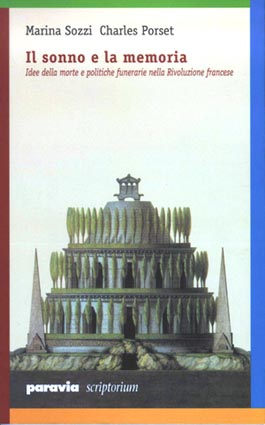Via E. De Sonnaz 13 - 10121 Turin (Italy)
Tel. 0039-11-547005 Fax 0039-11-547019
| HOME PAGE | ABOUT US | SCIENTIFIC COMMITTEE | HISTORY ARCHIVES | LIBRARY |
| PUBLICATION SRESEARCHES |
TRAINING | MEETINGS | SCHOLARSHIPS | LINKS |

IL SONNO E LA MEMORIA.
Idee della morte e politiche funerarie nella Rivoluzione francese
Scriptorium-Paravia, Torino, 1999
SLEEP
AND MEMORY. Ideas on Death and Funerary Policies during the French Revolution
by Charles Porset e Marina Sozzi
SUMMARY
Prefazione (Paolo Cristofolini)
Preface (Paolo Cristofolini)
MORTE E RITI FUNEBRI ALLA FINE DEL XVIII SECOLO: LA NASCITA DELL'IDEA CREMAZIONISTA
Death
and Funerary Rites at the end of the Eighteenth century:
Birth of the Idea of Cremation
by Marina Sozzi
1. Il Concorso sulle sepolture
(The Competition for interments)
1.1. Anno VIII. Il concorso viene bandito
(Year VII. The Competition is
announced)
1.2. L'indignazione e la protesta
(Consternation and protest)
2. Morte e riti nel XVIII secolo
(Death and rites in the Eighteenth century)
2.1. La concezione naturale della morte
(A natural conception of death)
2.2. Il rovescio della medaglia: la morte apparente
(The riverse of the medal:
catalepsys)
2.3. L'immortalità terrena o la posterità
(Earthly immortality or posterity)
2.4. Il corpo morto, la madre terra e il fuoco
(The dead body, the mother earth
and the fire)
2.5. Proposte e progetti cremazionisti
(Cremationist proposals and
projects)
3. Il dibattito sulla cremazione nei mémoires
(The discussion on cremation in the mémoires)
3.1. La cremazione, rito del passato pagano
(Cremation, a rite of the pagan
past)
3.2. La concezione filosofica del cosmo
(The philosophic conception of the
universe)
3.3 L'igiene pubblica
(The public hygiene)
3.4. Il lusso della cremazione
(The luxury of cremation)
3.5. La libertà di culto e di rito
(Freedom of cult and of rite)
3.6. Il fine morale delle istituzioni funebri
(The moral purpose of the funerary
institutions)
3.7. La ripugnanza
(The repugnance)
3.8. Ronesse e il divieto di cremare
(Ronesse and the prohibition of
cremating)
4. Epilogo
(Epilogue)
LA POLITICA FUNERARIA TRA RIVOLUZIONE E CONSOLATO NAPOLEONICO
The
Funerary Policy between the Revolution and the Napoleonic Consulate
by Charles Porset
1. Introduzione
(Introduction)
1.1 L'ancien Régime
(The Ancien Régime)
1.2 La Rivoluzione e la municipalizzazione dei cimiteri
(The Revolution and the municipalization
of cemeteries)
1.3 L'immortalità: eroi e comuni cittadini
(Immortality: herpes and common citizens)
1.4. L'interesse dell'Institut per i problemi delle
sepolture
(The Insitut’s concern for the
interment problems)
1.5. Il primo consolato e il concorso dell'anno VIII.
(The First Consulate and the
Competition of year VIII)
2. I documenti
(The documents)
Appendice 1 -Testi legislativi e regolamenti
(Appendix 1 – Law texts and rules)
1.1. Decreto di Fouché dell'anno II
(Fouché’s decree of year II)
1.2. Decreto di Maignet dell'anno II
(Maignet’s decree of year II)
1.3. Progetto di regolamento dell'Institut de France
(The Institut de France rules
project)
Appendice 2 -Lettere e discorsi
(Appendix 2 – Letters and speeches)
2.1. Lettera del cittadino Durant alla Convenzione
(Citizen Durant’s letter to the
Convention)
2.2 Proclamazione del premio del Concorso sulle sepolture
(discorso letto da Des Essartz il 15 vendemmiaio anno IX)
(Proclamation of the prize for the
Competition on interments (a speech read by Des Essartz on Vendemiaire the
15th, year IX)
2.3 Estratto da: Jean-François Champagne, Histoire abrégée
des travaux de la classe des sciences morales et politiques
(Abstract from: Jean-François
Champagne, Histoire abrégé des travaux de la classe des sciences morale set
politiques)
Appendice 3 - Biografie degli autori dei mémoires
(Appendix 3 – Biographies of the authors of the mémoires)
BIBLIOGRAFIA
(Bibliography)
INDICE DEI NOMI
(Index of the names)